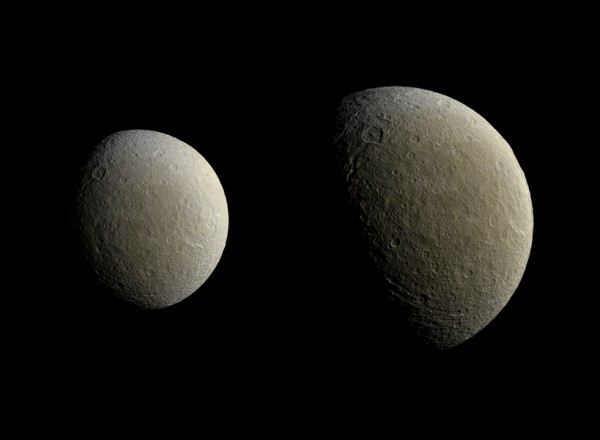Cassini Reveals First Hyper Color Images of Saturn's Mysterious Moon Rhea
| Ana Verayo | | Apr 01, 2015 04:35 AM EDT |
(Photo : NASA/JPL-Caltech/Space Science Institute) Images taken using clear, green, infrared and ultraviolet spectral filters were combined to create these enhanced color views, which offer an expanded range of the colors visible to human eyes in order to highlight subtle color differences across Rhea's surface.
These two images are apparently that of the icy, cratered moon Rhea, which is the second largest natural satellite of Saturn.
These high-definition, hyper color composite images of the mysterious moon is now seen for the first time in full color. They were taken February 9 by the Cassini spacecraft with its narrow angle camera and a few fillers from its wide angle camera.
Like Us on Facebook
The first image on the left was taken from a distance of 51,200 miles to 46,000 miles while the image on the right was captured at a somewhat closer distance of 36,000 miles to 32,100 miles during a close flyby.
The entire image was generated by Heike Rosenberg and Tilmann Denk at Freie Universität in Berlin. This flyby was originally intended for Saturn's other moon, Titan.
After Titan, Rhea is the next biggest moon of Saturn. Rhea spans some 950 miles across, which is less than a third of Titan's diameter.
It possesses very high reflective properties mainly caused by water ice that's harder than rock on the moon's extremely frigid surface battered by temperatures of -300 degrees Fahrenheit.
Rhea is also heavily pockmarked by huge craters, which is a sign of the extremely ancient beginnings of the solar system.
The Cassini mission was launched in 1997 and is a joint project of NASA and the European Space Agency. It arrived in Saturn in June 2004.
Its main mission is to explore the ringed planet and the composition of its rings, along with its moons, to better understand the gas planet and the early beginnings of the solar system.
Cassini is already on its last legs and will inevitably exhaust its last fuel reserves in the next two and a half years. To avoid any unwanted collisions with Saturn's moons, the tiny probe will go into its last closest flyby into Saturn's rings and into its abyssal atmosphere to burn up on its final, fiery mission.
Before this final dive into the gas planet, Cassini will continue to explore Saturn's moons and it will conduct a few more flybys of Titan, Dione and Enceladus. The probe recently revealed that Enceladus apparently has a giant ocean underneath its surface made up of salty, liquid water.
These stunning, never before seen images of Rhea from Cassini were taken when the probe was along its equatorial orbit around Saturn after observing the planet's polar regions. Next year, Cassini will change its orbit again and return observing Saturn's polar regions when its mission comes to an end.
TagsCassini Reveals First Hyper Color Images of Saturn's Mysterious Moon Rhea, NASA, ESA, Cassini probe, Saturn, Saturn moon rhea, cassini NASA saturn moon rhea
©2015 Chinatopix All rights reserved. Do not reproduce without permission
EDITOR'S PICKS
-

Did the Trump administration just announce plans for a trade war with ‘hostile’ China and Russia?
-

US Senate passes Taiwan travel bill slammed by China
-

As Yan Sihong’s family grieves, here are other Chinese students who went missing abroad. Some have never been found
-

Beijing blasts Western critics who ‘smear China’ with the term sharp power
-

China Envoy Seeks to Defuse Tensions With U.S. as a Trade War Brews
-

Singapore's Deputy PM Provides Bitcoin Vote of Confidence Amid China's Blanket Bans
-

China warns investors over risks in overseas virtual currency trading
-

Chinese government most trustworthy: survey
-

Kashima Antlers On Course For Back-To-Back Titles
MOST POPULAR
LATEST NEWS
Zhou Yongkang: China's Former Security Chief Sentenced to Life in Prison

China's former Chief of the Ministry of Public Security, Zhou Yongkang, has been given a life sentence after he was found guilty of abusing his office, bribery and deliberately ... Full Article
TRENDING STORY

China Pork Prices Expected to Stabilize As The Supplies Recover

Elephone P9000 Smartphone is now on Sale on Amazon India

There's a Big Chance Cliffhangers Won't Still Be Resolved When Grey's Anatomy Season 13 Returns

Supreme Court Ruled on Samsung vs Apple Dispute for Patent Infringement

Microsoft Surface Pro 5 Rumors and Release Date: What is the Latest?










